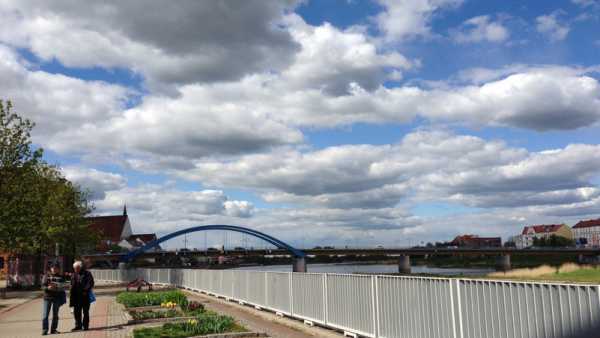
Bridge at Frankfurt-an-der-Oder, spanning the polluted river between Poland (right bank) and Germany (left bank) (Photo: Valentina Pop)
One of the most precious rivers in Europe faced a severe environmental disaster this summer. That river was the Oder, which forms the border between Poland and Germany.
Although two months have passed, there are still mixed reports as to the reasons why tonnes of dead fish were found in the river.
And despite the disaster, Poland’s plans for regulating the Oder will not help the river to revitalise itself and could instead exacerbate the situation.
Biohazard on the border
In August, the river was ravaged by a severe environmental disaster that killed fish and destroyed biodiversity which will take years to rebuild. Preliminary studies indicate that the decrease in fish biomass in the Oder river could be as high as 75 percent.
Although an official Polish report states that the causes of the catastrophe were natural, and blames golden algae, closer analyses show that the fault lies with human intervention, which polluted the water and turned large parts of the wild river and its tributaries into over-regulated channels.
Hydro-transformed riverbeds lose their self-cleaning abilities. Considering other factors like low water levels and polluting water with waste (the legal limits for discharging highly saline mine wastewater are very generous in Poland), it then becomes a recipe for disaster.
It was therefore hard not to be stunned when the Polish government announced that rather than supporting natural regulation measures, it would instead encourage further human engineering and interference to remedy the ecological disaster.
Pushing ahead with these plans would prevent the damaged ecosystem from ever recovering.
Financed with EU money — against EU rules
Unfortunately, Polish decision-makers are still deluded by the vision of Poland’s inland navigation power.
For them, the river is a navigation channel, not an eco-system that is important in terms of biodiversity, drought control and providing for local communities.
Warsaw wants to finance part of its inland navigation investments within the framework of operational programme FEnIKS, using EU Cohesion Policy funds.
This includes transforming the Oder into the international E30 waterway. Altogether, at least €200m worth of EU funds have been earmarked to support inland navigation investments, and a big part of this amount will go towards regulating the Oder. Poland’s sights are firmly set on developing inland navigation and doubling cargo transportation along the river.
Even though Brussels has halted virtually all EU funds for Poland until the country’s rule of law concerns are addressed, Poland has already begun to narrow and deepen the river and is also expanding its hydro-infrastructure.
All of these actions are designed to make the river, which hasn’t been used to accommodate large-scale river traffic in decades, navigable along most of its length.
Polish authorities claim that these investments are aligned with the ‘do no significant harm’ principle and nature protection laws.
But it is impossible to reconcile Poland’s dreams of inland navigation with environmental protection obligations under the EU’s water directive and biodiversity objectives. The EU’s Biodiversity Strategy for 2030 sets a target for at least 25,000km of waterways to be restored into free-flowing rivers.
Poland’s plans stand in direct contrast to this.
All these investments would undoubtedly be disguised as flood protection, anti-drought actions and measures for providing clean transport.
However, this approach stands in contrast to the position of science. The investments will not only cause the disappearance of many species of plants and animals, but also will put the areas at risk of drought, as groundwater will subsequently fall into a deepened river.
The river’s self-cleaning capacity will be weakened and it will never fully recover after last summer’s catastrophe.
A study by the EU’s Joint Research Centre a few years ago indicates that the best flood protection method in Poland is river restoration. Experts from the Polish Academy of Sciences wrote: “Regulatory works should be halted and steps should be taken to renature the Oder and its tributaries and at least parts of its floodplain valley with a view to increasing the river’s buffer capacity and its adaptation potential to climate change and other anthropogenic disturbances.”
At a time when biodiversity loss has reached a critical point, disasters such as the one that befell the Oder are simply unacceptable.
This case should serve as a serious wake-up call highlighting the need to ensure genuinely sustainable and non-destructive investments.
Any support for river regulation should be excluded from EU funds and instead redirected to river restoration and protection measures.
Institutions such as the World Bank and the Council of Europe Development Bank should also stop funding such plans. Otherwise, similar catastrophes will keep repeating themselves.
Source: euobserver.com



